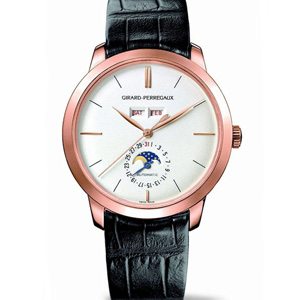The timepieces worn by the cinematic James Bond–from the Gruen 510 he sported in Dr. No to the Omega Seamaster around his wrist in Spectre–have been exhaustively chronicled. The watches 007 has worn onscreen include the Breitling, Pulsar (made by Hamilton), Rolex Submariner, Rolex (Pre-Daytona) Chronograph, Seiko, TAG Heuer Professional dive and the aforementioned Gruen and Omega.
However, Bond’s horological interest was piqued long before he hit Hollywood. Literary 007–and his creator, Ian Fleming–were both watch aficionados. In an example of life imitating art, a Girard-Perregaux that Fleming describes in detail in From Russia With Love (published in 1957) is one Bond might or might not have worn, a complement to his top-notch wardrobe of (one assumes) shirts from Turnbull & Asser and Benson, Perry & Whitely on Cork Street, just off London’s Savile Row. (None of Bond’s tailors is ever mentioned by name in the books, but these were Fleming’s personal favorites. He did have 007 smoke handmade cigarettes from Morland & Co., however.) The particular Girard-Perregaux Fleming mentions, though, didn’t become a production GP until more than a half-century later.

From Russia with Love Dust Jacket
Dell Deaton, creator of JamesBondWatches.com, has conducted some doctorate-worthy research into which exact watches adorned the wrist of the world’s most suave secret agent. In Chapter 27 of From Russia With Love–its legions of fans included John F. Kennedy, who called it one of his favorite books–a bullet fired by the villainous Donovan “Red” Grant destroys Bond’s watch. After dispatching Grant, Bond does the only logical thing, pilfering the dead man’s timepiece as a combination trophy and replacement.
In Chapter 1, Fleming had described Grant’s watch as “…a bulky gold wristwatch on a well-used brown crocodile strap. It was a Girard-Perregaux model designed for people who like gadgets, and it had a sweep second-hand and two little windows in the face to tell the day of the month, and the month, and the phase of the moon.” This is an exact description of the Girard-Perregaux 1966 full calendar, but the 1966 Collection didn’t launch until SIHH 2011; the 1966 full calendar followed at SIHH 2012. Yet when the assassin departs on his mission to kill Bond, he’s sporting a “battered silver wristwatch with an old leather strap,” as 007 observes in Chapter 25.
Despite that switcheroo, some Bond devotees insist that the timepiece lifted from Grant’s body was, in fact, a Girard-Perregaux. To settle the mystery at last, Deaton headed to the archives at Indiana University’s Lilly Library, where Fleming’s papers are stored.
First, he confirmed that Fleming’s original manuscript mentioned a “silver wristwatch” on Grant’s wrist during his kill mission. Noted Deacon, “Reading through that, I found closely discernible on page 196 (behind Fleming’s extensive handwritten revisions to the latter part of this draft), exactly as it had come off his Imperial [typewriter], this: Grant wearing ‘a battered silver wristwatch with an old strap.’ It is a silver wristwatch. I could also see that the word ‘leather’ was added later, most likely during Fleming’s routine evening reread of pages produced each morning prior.”
So, while Girard-Perregaux unquestionably makes an appearance in one of Bond’s most famous adventures, Britain’s favorite superspy didn’t actually slip one on. That, of course, doesn’t prevent him from doing so in a future mission.
As to whether Fleming should receive posthumous design credit for the Girard-Perregaux 1966 “Red Grant” full calendar, GP product-development director (and former CEO) Stefano Macaluso confesses: “We were of course always aware of Fleming’s reference in From Russia With Love. So [when we] decided to create a classic full calendar, we looked in archival 1950s catalogs to get an idea as to what watch [would have] inspired him. We found a calendar watch without moon phase, so we supposed that Fleming added the moon phase to emphasize the werewolf element in which Grant kills his victims only when there is a full moon. As a consequence, we decided to add the moon phase into the modern watch.”

Girard-Perregaux Full Calendar
Macaluso adds that prior to the release of the 1966 full calendar, Girard-Perregaux had “a long official negotiation to mention Fleming in our communication [and press materials], but finally the author’s family decided to stop because of potential troubles with Omega. So this connection would stay unofficial.” Count us a little shaken—and definitely stirred.
Images ©: Header; Eon Productions. 1; Jonathan Cape c/o Peter Harrington London. 2; Girard-Perregaux.
Get More Articles Like This in Your Inbox
We're constantly creating great content like this. So, why not get it delivered directly to your inbox? By subscribing you agree to our Privacy Policy but you can unsubscribe at any time.






